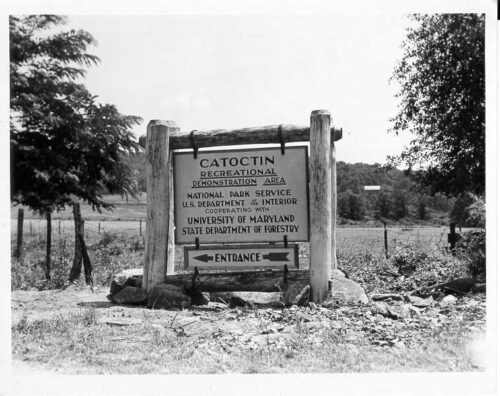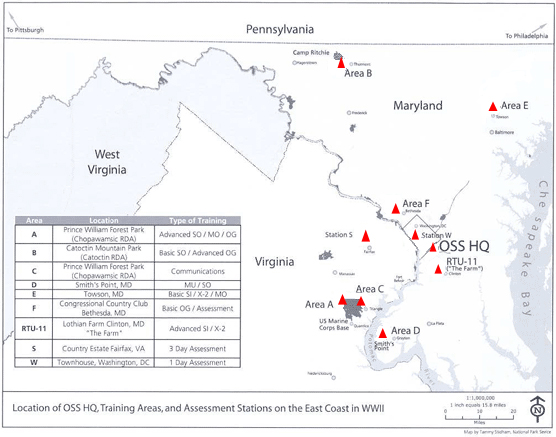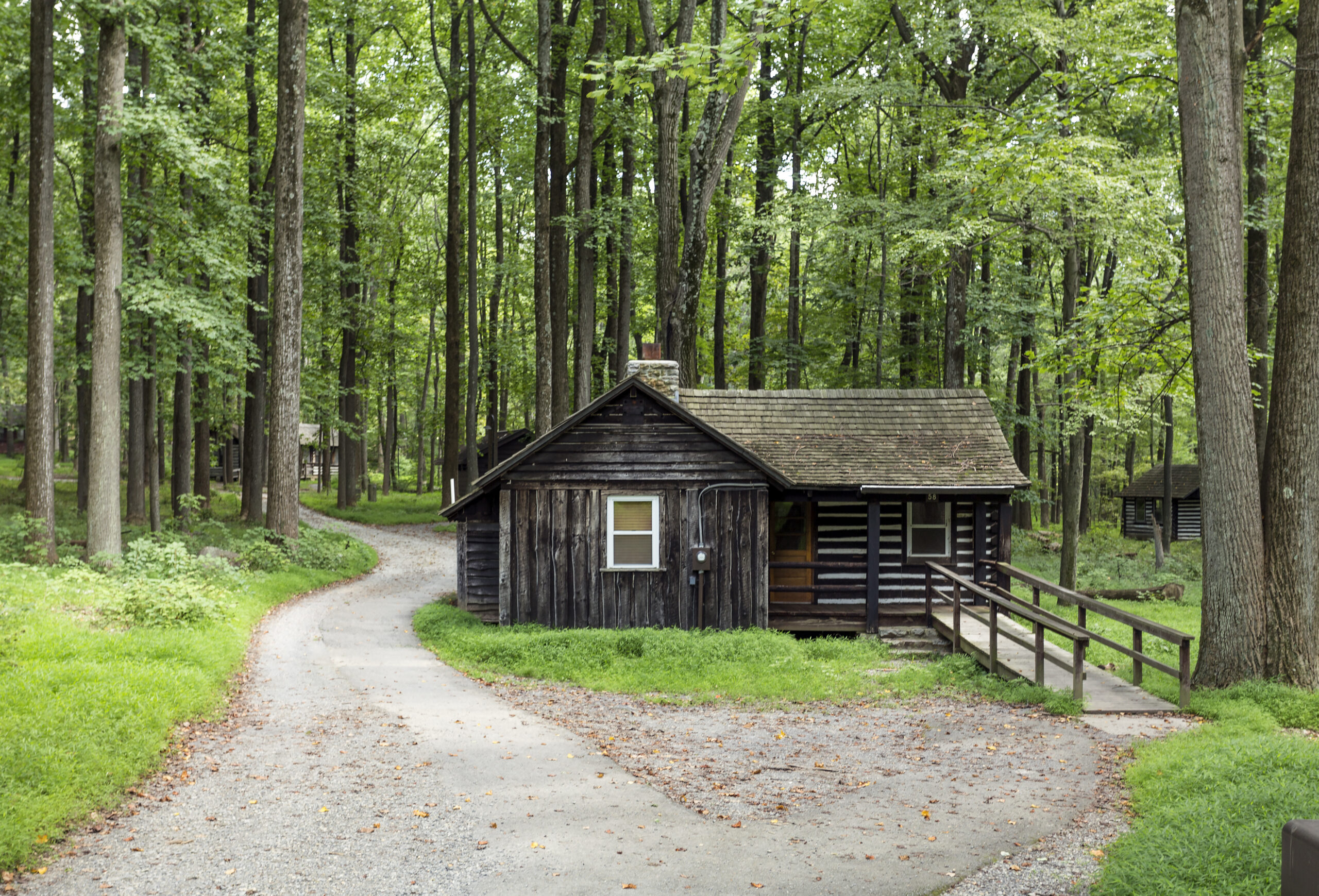Camp Greentop, Catoctin Mountain Park, Maryland. Photo taken on 26 August 2016. Credit: Acroterion / CC BY-SA 4.0 DEED.
In a global and totalitarian war, intelligence must be global and totalitarian.” — Major General William J. Donovan
During World War II, the tranquil trails and forested hills of Maryland’s Catoctin Mountain Park concealed a secret that would significantly impact American history. This serene location was chosen as a training site for the Office of Strategic Services (OSS), America’s first all-purpose intelligence agency.
The Office of Strategic Services (OSS)
The OSS was formed to aid the Allied cause in World War II, gathering information about the enemy, aiding resistance groups, and sabotaging enemy assets. The OSS recruited America’s social elite and top minds, as well as burglars and con men. The OSS created a new training program for this new mission.
The OSS was a revolutionary organization that included a diverse group of recruits, from Ivy League university graduates to artists, writers, conmen, forgers, and active-duty military personnel. All were under the direction of World War I hero, Major General William “Wild Bill” Donovan. Donovan’s ideal recruit was “a PhD who could win in a bar fight”.

OSS Training at Catoctin Mountain
To train these recruits in the arts of espionage, hand-to-hand combat, intelligence gathering, and sabotage, Donovan established secret training camps. The U.S. national parks, including Catoctin Mountain Park, then known as Catoctin Recreational Demonstration Area (RDA), were the perfect locations for these camps due to their remoteness, seclusion, and federal ownership.

Catoctin Mountain Park, now home to the U.S. president’s rural retreat Camp David, was one of the largest OSS training camps. The OSS took over several sites within Catoctin, including Camp Greentop, Camp Round Meadow, and the areas surrounding what later became Camp David. The Catoctin RDA had been partially developed by the Civilian Conservation Corps (CCC) and Works Progress Administration (WPA) during the 1930s. Camp Greentop, constructed in 1938, was the first camp in the U.S. built for children with physical disabilities.
The Catoctin RDA was instrumental in providing training to personnel from Special Operations (SO), Secret Intelligence (SI), and Operational Groups (OG). The SO’s training program was inspired by the British Special Operations Executive (SOE), encompassing instruction in parachuting, sabotage, self-defense, weaponry, and leadership to aid in guerrilla or partisan warfare. This location was known as Area “B”, a hub for Basic Special Operations training. Officers and enlisted men from the OSS were stationed at Camp #2, now known as Camp Greentop, which was referred to as Area “B-2”.
In September 1942, the permanent cadre relocated to a deserted camp that was formerly operated by the Civilian Conservation Corps (CCC). This camp is presently recognized as Camp Round Meadow and is situated approximately one mile to the west, in an area known as B-5.

The Training Process
The men recruited by the OSS arrived at Catoctin with nothing. They were given everything they needed upon arrival, including false identification documents. All trainees were to remain anonymous. Their mission, location, or true identity was to be kept secret. Trainees were given a name badge with a fictitious student name such as “Joe” or “Fred.” OSS training films showed instructors and trainees wearing black masks to protect their identities. If the trainees went to Hagerstown or Gettysburg for an evening on leave, they had to be careful not to divulge any information. All trainees were closely watched even outside of the camp.
The OSS recruits, known as Donovan’s “Glorious Amateurs,” underwent rigorous training. The training of the recruits wasn’t confined to the mountains, they frequently ventured from Catoctin to the neighboring cities of Baltimore, Philadelphia, and Richmond to execute simulated “missions.”
To provide the most sophisticated training, the OSS had to construct its own facilities from the ground up, including various obstacle courses. The Natioal Park Service (NPS) reports that the inaugural obstacle course at Catoctin, established in 1942 along Owens Creek, consisted of two ropes that trainees had to traverse while carrying hefty knapsacks.
The most notable obstacle course constructed at Catoctin was the “Trainazium,” an enormous wooden structure standing 18 feet tall, built from a dozen oak trees, resembling a massive jungle gym.
However, the challenges were not limited to rope courses. A walking path known as the “Demolition Trail” was situated between Camp Greentop and Camp Round Meadow. As trainees moved between the two camps, instructors would sporadically detonate small explosive charges, effectively teaching the students to maintain a low profile and keep their heads down.
The House of Horrors.
The “House of Horrors,” also known as the “Pistol House,” “Haunted House,” and “Mystery House,” was the most expensive structure built by OSS at Catoctin. It cost around $120,000 in today’s dollars. A unique facility for its time, it was designed by the SOE to provide realistic close-quarters pistol training. It was situated in Camp Greentop, at the current location of the stables.
Trainees, accompanied by an instructor, would enter the house armed with a standard U.S. military issue M1911A1 .45 ACP pistol. The house was designed to mimic a building occupied by Nazis, with the interior kept in complete darkness. The floors were intentionally made unstable and included frequent drops to simulate real-world conditions.
A concealed phonograph played realistic sounds, including conversations in German, adding to the authenticity of the training scenario. As the trainees navigated through the house, they would encounter papier-mâché figures representing Nazis, armed with pistols.
William E. Fairbairn
During World War II, the now legendary William E. Fairbairn was recruited by the SOE as an Army officer, where he was given the nickname “Dangerous Dan”. He trained British, American, Canadian Commandos, and No. 2 Dutch Troop 10th Inter-Allied Commando forces, along with Ranger candidates in close-combat, pistol-shooting, and knife-fighting techniques.
Fairbairn was also instrumental in training special operations agents at top-secret sites in the United Kingdom and North America. One such location was the training facility in Catoctin Mountain Park. His training methods were so effective that they were captured in a training film for anonymity. Fairbairn’s contribution to the war effort was significant, and his methods continue to influence modern close-combat training.
Legacy of the OSS.
The OSS’s operations at Catoctin Mountain Park played a crucial role in helping the Allies win the Second World War. From the ashes of the OSS, today’s Central Intelligence Agency (CIA) and U.S. Special Forces were born. The park’s hidden past serves as a reminder of the significant role it played in shaping the course of American and world history. The training program established by the OSS during World War II is considered a legacy and has influenced the CIA training program today.
Catoctin Mountain Park, with its tranquil trails and forested hills, holds a significant place in the history of American intelligence and espionage. The park’s role as a training ground for the OSS during World War II is a testament to its historical importance. Today, visitors to the park can enjoy its natural beauty while also appreciating its contribution to the nation’s history.
Visiting Catoctin Today
The original 10,000-acre Catoctin Recreational Demonstration Area now consists of two parks: Catoctin Mountain Park and neighboring Cunningham Falls State Park. Both parks accept visitors year-round. While Camp David is strictly off-limits (for obvious reasons), there are tons of hiking trails, camp sites, picnic spots, and scenic drives the public can enjoy throughout Catoctin Mountain Park. Camp Greentop isn’t open to daily visitors, but the entire camp including the original OSS cabins can actually be rented for group functions.
Resources
Catoctin Mountain Park
NPS.gov
Office of Strategic Services Society
OSSSociety.org
USASOC OSS Website (Official US Army Website)
www.soc.mil/OSS/index.html
Central Intelligence Agency
CIA.gov
*The views and opinions expressed on this website are solely those of the original authors and contributors. These views and opinions do not necessarily represent those of Spotter Up Magazine, the administrative staff, and/or any/all contributors to this site.
